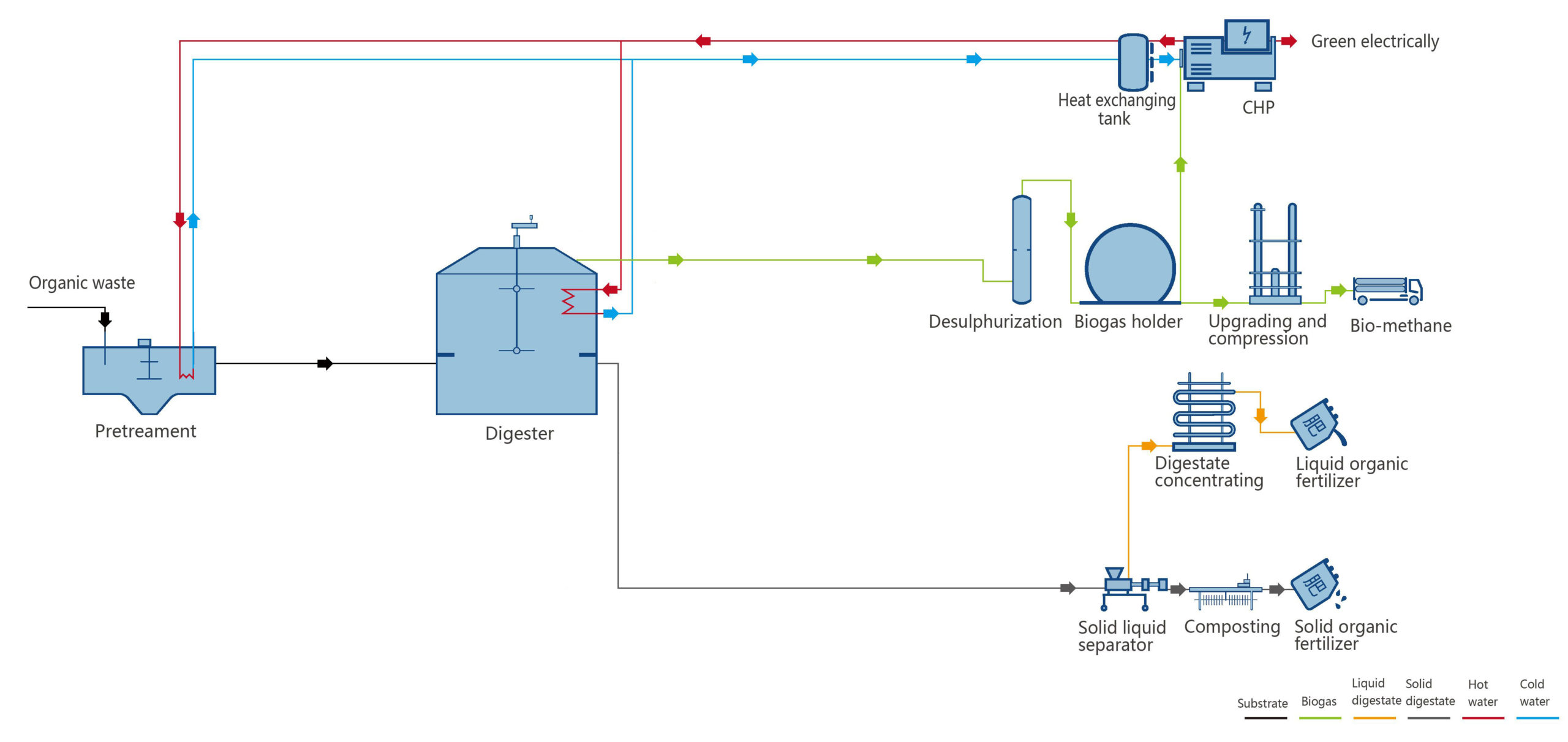Technology
Welle Biogas Technology: A Better Way to Transform Waste To Energy
Welle Biogas systems are currently operating in 15 countries and regions around the world, with technology and equipment developed and perfected over 30 years in the environmental engineering industry.

Typical Process Flow
Pretreatment
The first step in the production of biogas is the pre-treatment process, which makes the material physically, chemically and biologically ready for stable and efficient biogas production. Based on the type of organic waste, Welle Biogas has developed different pretreatment technologies and equipment combinations to maximize biogas and byproduct yield:
- Removal of floating layers and heavy impurities to avoid inefficient anaerobic digestion
- Sand removal from organic matter to reduce maintenance frequency and cost
- “Thick” and “thin” streams split for low total solid (TS%) feedstock to optimize digester volume and minimize energy consumption
- Particle size reduction and pre-AD hydrolysis to enable higher organic loading, faster biogas production rate and lower capital investment.

Anaerobic Digestion
The pretreated organic matter is then pumped into a CSTR (Continuous Stirred Tank Reactor) for anaerobic digestion (AD). Welle’s advanced CSTRs are often operated at mesophilic conditions (35-38℃) and used either in parallel or in sequence to produce methane-enriched biogas. Our proprietary, highly efficient agitation system is equipped with an AD tank to improve the homogeneity of the feedstock and ensure uniform temperature in the digester.
Welle’s AD systems offer a number of unique benefits:
- Strong tolerance of feedstocks with a high concentration of solids
- Strong ability to withstand high shock loading
- Highly efficient agitation system that consumes 50% less energy compared to conventional mixers.

Biogas Desulphurization
The biogas produced by anaerobic digesters typically contains hydrogen sulfide (H2S) and suspended particulate impurities. H2S is not only toxic, it is also corrosive to equipment. The existence of H2S and impurities will shorten the lifetime of any AD system. Biogas desulfurization treatment is therefore necessary to remove the H2S and protect treatment equipment.
Welle Biogas offers two proprietary desulfurization systems, one for electricity and one for renewable natural gas (RNG). Both systems are efficient, low-cost solutions for all biogas desulfurization needs, providing the following benefits:
- Modular design easily meets a wide range of biogas flow rate and H2S loading request.
- 99% stable H2S reduction rate, delivering <100 ppm H2S after desulphurization
- No air/oxygen is added to the biogas for RNG production, so there is no risk of secondary contamination.

Storage
Once desulphurization takes place, the resulting biogas is stored in a double-membrane biogas holder that uses a special biogas-type membrane coated with special PVC that resists ultraviolet radiation, preventing premature aging of the membrane. It can also resist corrosion of H2S, avoid methane permeation and has excellent folding endurance, all of which ensure the safety and reliability of biogas storage.

Biogas Utilization
Clean biogas can be used to generate green electricity through combined heat and power (CHP) systems, which can power electric vehicles, generate renewable hydrogen, or simply be consumed on site as clean electricity. Alternatively, biogas can be upgraded by water wash, membrane, or PSA technologies to generate RNG, providing low or negative carbon emission fuel or energy options to the world. In addition, food-grade or industry-grade CO2 can also be produced in this process and can be used in food/beverage processing or controlled environmental agriculture (CEA).
The biogas team at Welle have worked with most major CHP and biogas upgrading system vendors around the world, enabling optimal selection and integration of these systems into the overall biogas plant.

Digestate Utilization
In addition to biogas, the CSTR process produces a digestate that can be converted into solid and liquid fertilizer. These nutrient-rich products can be used on the farm or sold to local or regional agricultural or horticultural suppliers. This additional revenue stream helps diversify the farmers’ business while improving soil and protecting local water resources from nutrient runoff and harmful pathogens.

